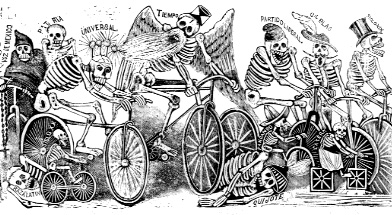The day of the dead, or Día de Muertos, is one of Mexico’s most popular traditions around the world, and it is specially famous and attractive because of it approach to honouring dead and the people that aren’t in this world anymore. The celebration is colourful, cheerful and playful, and there is a lot of satire about the dead but in a respectful way. The dead is not seen as the end of a person’s life, but as the end of the physical body’s life. The original Aztec believe is that the person’s soul goes to Mictlan, the Aztec underworld, a peaceful place, home of the souls, where they wait until they assigned day to go back and visit their living loved ones. There are many traditions and iconography that I won’t show here, but I will leave some images as examples:
These are skulls made out of sugar, and in most place they are made of chocolate too.
Traditional bread.
Altars.
One of the most representative icons of Día de los Muertos is the Catrina.
But there is a big confusions that has changed some traditions. This image, the catrina, was created by José Guadalupe Posada, a cartoonist and illustrator from Aguascalientes who worked with lithography and engraving. He became famous because of his satire of everyday life situations represented with skeletons, as dead people, doing what living people do. He worked at a newspaper doing illustrations for the news and telling them in the form of rhymes, real events, told in an entertaining way, illustrated with these skeletal images:
Most of these news were tragical events, such as accident, natural disasters, etc. and the intention wasn’t to make fun of them, but telling them in a fun way, using poetry and art, although, as far as I know, the intention of the publication wasn’t to be a piece of art, but a pure and simple newspaper telling the latest events.
The confusion & the creation of the Catrina
The Catrina started with this publication:
But its name was never “Catrina”, its original name was “Calavera Garbancera” and it was not meant to be a character, it was also never meant to be the representation of dead. The work, titled “Remate de Calaveras Garbanceras” (Sale of Calaveras Garbanceras) is a critic to indigenous people that used to pretend to be European, more specifically Spanish or French, by dressing with fake jewelry and trying to be fancy; “Garbancera” was a term used to call these people, who sold beans to make a living but tried to act like the higher class. This image was created in 1913, and by 1947 the famous muralist Diego Rivera took the image and incorporated it into his mural “Sueño de una tarde dominical en la Alameda Central”
Detail from the mural
It was Diego Rivera who made the image famous, and it was also Diego who named it “Catrina”. My personal guess is that he used the word “Catrín”, which is a man dressing elegantly, and added the “a” to make it a female word. After this the image started to become a traditional Mexican icon.
I don’t have a problem with this confusion, history is made out of mistakes and random events, many of them are wrong and non-existent. I like the fact that we adopted this character as a representation of dead.
In my film I will be using these ideas, referencing the Catrina in a subtle way, that I will explain later, and taking the idea of satire and fun interpretation of dead. I will also use a modern version of the dead, avoiding seriousness and tradition, but without losing respect to it.
Why San José?
The name has a personal reason, that I will explain shortly. In Mexico I live in a ranch, in the middle of a small town
The images are a little blurry, but those are the only ones I have right now :(
The stone fence separates four different properties, owned by different people, but last summer I found out that those four were originally together, owned by one person and the whole place was called San José, it was considered a separate town, next to San Lorenzo, the bigger town. Legally, the place is part of San Lorenzo, but historically it is a separate place, and people say “I’m going to San José”, everybody in San Lorenzo knows it as San José, up to date, people refer to it as a neighbour town, populated by around 10 people, including my family and the neighbours. The current name is “El Jacal”, people also know this name, but whenever I go to San Lorenzo and say that I live in “El Jacal” they say “oh, so you are one of the people from San José”. Historically I have my own town, that has been there for about 100 years, and it is one of the places in the world that I love the most, I wasn’t born there, but I grew up there.
That is the reason for the name. The film will also have a small town, called, of course, San José.
Thanks for reading ;)
Fernando





.jpg)




No hay comentarios:
Publicar un comentario